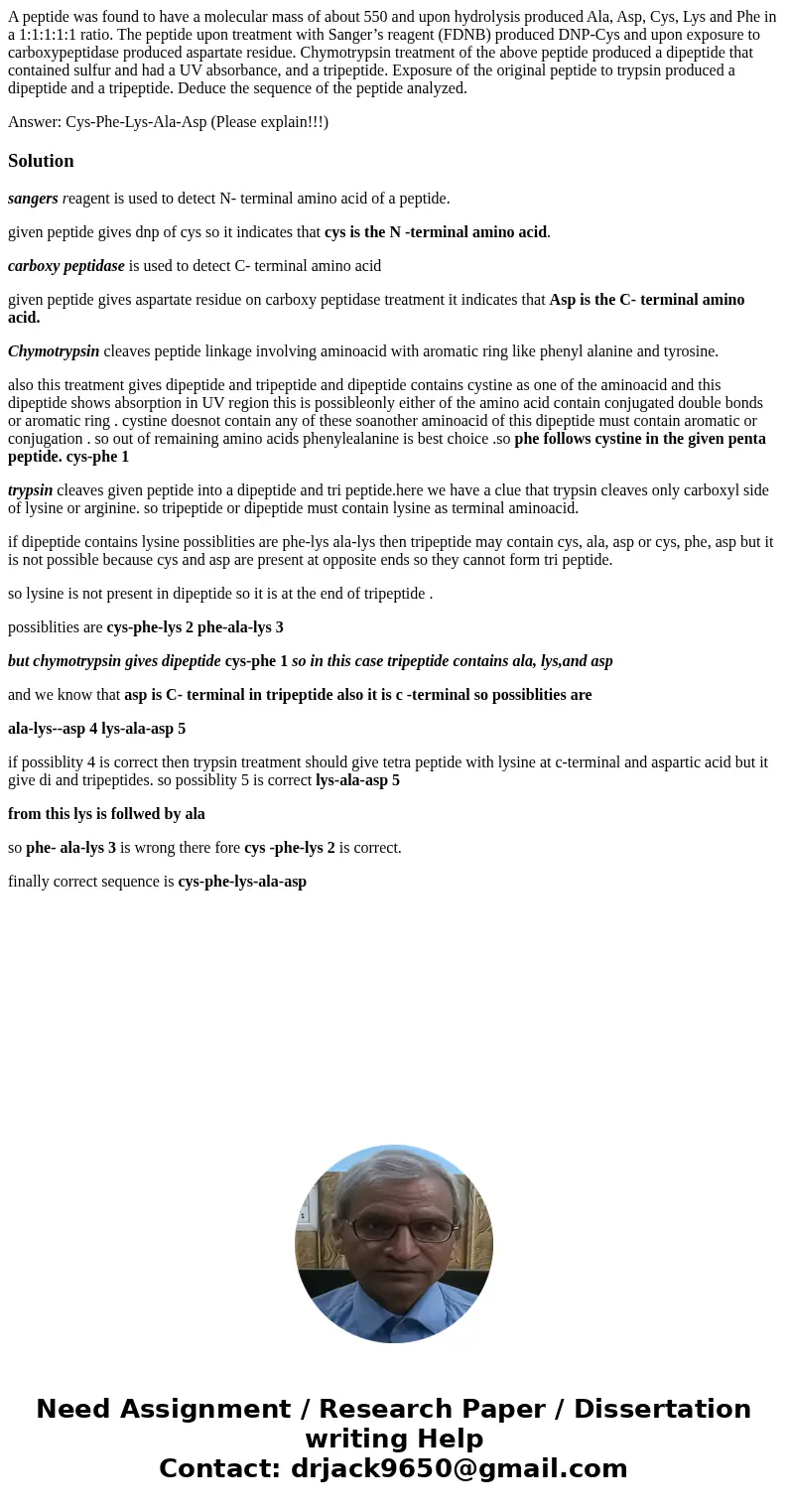A peptide was found to have a molecular mass of about 550 an
A peptide was found to have a molecular mass of about 550 and upon hydrolysis produced Ala, Asp, Cys, Lys and Phe in a 1:1:1:1:1 ratio. The peptide upon treatment with Sanger’s reagent (FDNB) produced DNP-Cys and upon exposure to carboxypeptidase produced aspartate residue. Chymotrypsin treatment of the above peptide produced a dipeptide that contained sulfur and had a UV absorbance, and a tripeptide. Exposure of the original peptide to trypsin produced a dipeptide and a tripeptide. Deduce the sequence of the peptide analyzed.
Answer: Cys-Phe-Lys-Ala-Asp (Please explain!!!)
Solution
sangers reagent is used to detect N- terminal amino acid of a peptide.
given peptide gives dnp of cys so it indicates that cys is the N -terminal amino acid.
carboxy peptidase is used to detect C- terminal amino acid
given peptide gives aspartate residue on carboxy peptidase treatment it indicates that Asp is the C- terminal amino acid.
Chymotrypsin cleaves peptide linkage involving aminoacid with aromatic ring like phenyl alanine and tyrosine.
also this treatment gives dipeptide and tripeptide and dipeptide contains cystine as one of the aminoacid and this dipeptide shows absorption in UV region this is possibleonly either of the amino acid contain conjugated double bonds or aromatic ring . cystine doesnot contain any of these soanother aminoacid of this dipeptide must contain aromatic or conjugation . so out of remaining amino acids phenylealanine is best choice .so phe follows cystine in the given penta peptide. cys-phe 1
trypsin cleaves given peptide into a dipeptide and tri peptide.here we have a clue that trypsin cleaves only carboxyl side of lysine or arginine. so tripeptide or dipeptide must contain lysine as terminal aminoacid.
if dipeptide contains lysine possiblities are phe-lys ala-lys then tripeptide may contain cys, ala, asp or cys, phe, asp but it is not possible because cys and asp are present at opposite ends so they cannot form tri peptide.
so lysine is not present in dipeptide so it is at the end of tripeptide .
possiblities are cys-phe-lys 2 phe-ala-lys 3
but chymotrypsin gives dipeptide cys-phe 1 so in this case tripeptide contains ala, lys,and asp
and we know that asp is C- terminal in tripeptide also it is c -terminal so possiblities are
ala-lys--asp 4 lys-ala-asp 5
if possiblity 4 is correct then trypsin treatment should give tetra peptide with lysine at c-terminal and aspartic acid but it give di and tripeptides. so possiblity 5 is correct lys-ala-asp 5
from this lys is follwed by ala
so phe- ala-lys 3 is wrong there fore cys -phe-lys 2 is correct.
finally correct sequence is cys-phe-lys-ala-asp

 Homework Sourse
Homework Sourse